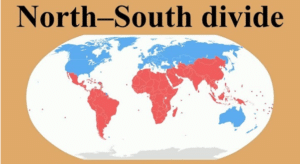The New Discourse of Global South.
Relevance
- GS Paper 2.
- Bilateral, regional, and global groupings and agreements involving India and/or affecting India’s interests.
- Effect of policies and politics of developed and developing countries on India’s interests, Indian diaspora.
- Tags: #globalsouth #globalnorth #india #internationalrealtions #currentaffairs #upsc.
Why in News?
India’s G20 presidency is being considered as a Bridge for the North-South divide.
Rethinking the Global North-South Divide
- The conventional categorization of nations into ‘developed’ and ‘developing’ has become less clear as the lines between economic progress and cultural identity blur.
- While economic indicators have traditionally determined these divisions, the emerging concept of the Global South emphasizes the importance of cultural distinctions in shaping the narrative of development.
Economic Discrepancies and Cultural Identity
- The Global South stands out as a cultural identity marker, highlighting the nuanced differences between nations beyond mere economic numbers.
- For instance, China, with a population of over 2 billion and a per capita GDP of $34,000, is deemed ‘developing,’ while India, with a GDP of $3.75 trillion but a per capita GDP of only $2,700 due to its immense population, is classified similarly.
- Despite India’s impressive performance in various development indices, the focus on per capita GDP often overshadows its accomplishments.
India’s Transformation and the Role of Leadership
- India’s economic transformation, particularly in the past decade, has been significant. Morgan Stanley predicts that Prime Minister Narendra Modi’s reforms will lead India’s economy to cross $8 trillion by 2031, achieving a per capita GDP of over $5,200.
- The country’s infrastructure growth has been noteworthy, with the introduction of metro rail projects, new airports, and advancements in railways and highways. Additionally, India’s achievements in space technology, including the Chandrayaan-3 mission, have positioned it as a technological frontrunner.
- Engagement on a Multilateral Front: India takes an active role in various international platforms, including the United Nations, G20, BRICS, and IBSA, utilizing these forums to effectively convey the concerns and priorities of the Global South.
- Promotion of South-South Collaboration: India champions the cause of South-South cooperation, underscoring the significance of collaborative efforts and reciprocal support among developing nations.
- Bridging Divides between North and South: With its foreign policy objective of bridging the gap between the Global North and the Global South, India assumes a pivotal role as a potential mediator and facilitator of constructive dialogues.
Redefining Development: Challenges in Classification
- The traditional classification of ‘developed’ and ‘developing’ countries lacks consensus. Organizations like the World Trade Organization and the United Nations lack clear definitions.
- Bill and Melinda Gates have argued that these terms are no longer useful, predicting a world with almost no ‘poor countries’ by 2035. The Global South concept proposed by India’s leadership presents an alternative perspective for discussing issues affecting countries that are striving to achieve sustainable development.
Cultural Differences as the New Dividing Line
- As the Global South concept gains prominence, it becomes evident that the distinction between the Global North and South is more than just economic.
- Cultural issues, lifestyle changes, and sustainability efforts take center stage. While the North has historically been associated with overconsumption and its consequences, the South, comprising regions like Latin America, Africa, and Asia, emerges as a beacon for a more ecologically balanced and globally conscious worldview.
As debates continue regarding the classification of nations, the Global South concept put forward by India’s leadership aims to redefine development beyond economic metrics. It emphasizes the importance of cultural identity and aligns with the growing focus on sustainability, ecological balance, and universal healthcare. This approach contrasts with the traditional ‘developing’ versus ‘developed’ discourse, carrying the potential to shape a more inclusive and culturally sensitive global culture.
| Traditional Global South
· The term “Global South” pertains to nations frequently labeled as ‘developing,’ ‘less developed,’ or ‘underdeveloped.’ · It encompasses countries across Africa, Asia, and Latin America, marked by elevated levels of poverty, income disparity, and challenging living circumstances when contrasted with the “Global North.” · On the other hand, the “Global North” refers to well-developed countries such as the United States, Canada, various European nations, Russia, Australia, and New Zealand. Emergence of the Global South Concept · The term “Global South” had its origins in 1969 when political activist Carl Oglesby introduced it to highlight the culmination of northern dominance over the global south in the context of the Vietnam War. · However, the concept gained substantial traction only after the dissolution of the Soviet Union in 1991, which marked the conclusion of the “Second World” era. The framework of a three-world analogy was initially coined by French demographer Alfred Sauvy in 1952, distinguishing: 1. The “First World,” representing advanced capitalist nations, 2. The “Second World,” denoting socialist nations led by the Soviet Union, and 3. The “Third World,” signifying developing nations, many of which were still influenced by colonial powers. · The decline of the “Second World” ensued with the fall of the Soviet Union, consequently leading to a waning use of the term “Third World.” Concurrently, criticisms grew concerning the negative implications associated with the label, often portraying developing nations as impoverished, unstable, and underdeveloped. · To address these concerns and establish a more impartial and encompassing vocabulary, the term “Global South” emerged as an alternative. It sought to transcend the limitations of the previous classification and provide a broader perspective on nations striving for progress. · Illustrating the division between the Global North and the Global South based on economic disparities, the Brandt Line gained prominence in the 1980s. Proposed by German statesman Willy Brandt, this visual representation highlighted the stark economic contrast between these two global regions. |
Sources: Indian Express
Mains Question:
Q Discuss the evolution and significance of the concept of the “Global South” in international discourse. How has this concept reshaped the traditional understanding of global development and cooperation? Illustrate your answer with relevant examples. 250words.




